国际贸易名词解释英文及简答论述期末考试复习
国际贸易实务(英语版)期末考试总结
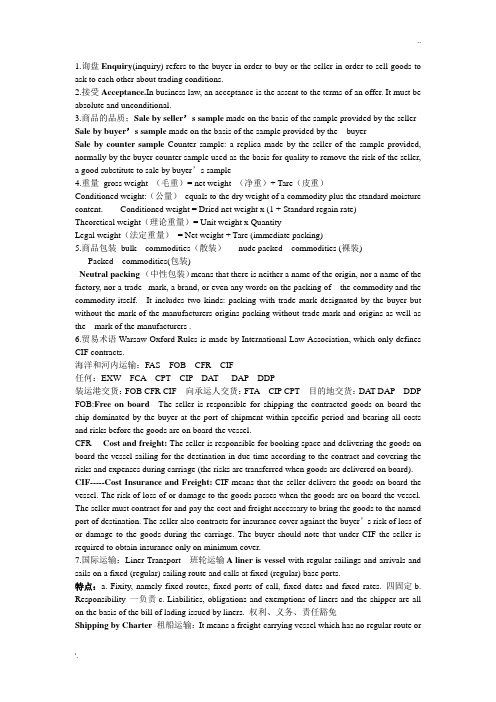
1.询盘Enquiry(inquiry) refers to the buyer in order to buy or the seller in order to sell goods to ask to each other about trading conditions.2.接受Acceptance.In business law, an acceptance is the assent to the terms of an offer. It must be absolute and unconditional.3.商品的品质;Sale by seller’s sample made on the basis of the sample provided by the seller Sale by buyer’s sample made on the basis of the sample provided by the buyerSale by counter sample Counter sample: a replica made by the seller of the sample provided, normally by the buyer counter sample used as the basis for quality to remove the risk of the seller,a good substitute to sale by buyer’s sample4.重量gross weight (毛重)= net weight (净重)+ Tare(皮重)Conditioned weight:(公量)equals to the dry weight of a commodity plus the standard moisture content. Conditioned weight = Dried net weight x (1 + Standard regain rate)Theoretical weight(理论重量)= Unit weight x QuantityLegal weight(法定重量)= Net weight + Tare (immediate packing)5.商品包装bulk commodities(散装)nude packed commodities (裸装)Packed commodities(包装)Neutral packing (中性包装)means that there is neither a name of the origin, nor a name of the factory, nor a trade mark, a brand, or even any words on the packing of the commodity and the commodity itself. It includes two kinds: packing with trade mark designated by the buyer but without the mark of the manufacturers origins packing without trade mark and origins as well as the mark of the manufacturers .6.贸易术语Warsaw-Oxford Rules is made by International Law Association, which only defines CIF contracts.海洋和河内运输:FAS FOB CFR CIF任何:EXW FCA CPT CIP DAT DAP DDP装运港交货:FOB CFR CIF 向承运人交货:FTA CIP CPT 目的地交货:DA T DAP DDP FOB:Free on board The seller is responsible for shipping the contracted goods on board the ship dominated by the buyer at the port of shipment within specific period and bearing all costs and risks before the goods are on board the vessel.CFR----Cost and freight: The seller is responsible for booking space and delivering the goods on board the vessel sailing for the destination in due time according to the contract and covering the risks and expenses during carriage (the risks are transferred when goods are delivered on board). CIF-----Cost Insurance and Freight: CIF means that the seller delivers the goods on board the vessel. The risk of loss of or damage to the goods passes when the goods are on board the vessel. The seller must contract for and pay the cost and freight necessary to bring the goods to the named port of destination. The seller also contracts for insurance cover against the buyer’s risk of loss of or damage to the goods during the carriage. The buyer should note that under CIF the seller is required to obtain insurance only on minimum cover.7.国际运输:Liner Transport 班轮运输A liner is vessel with regular sailings and arrivals and sails on a fixed (regular) sailing route and calls at fixed (regular) base ports.特点:a. Fixity, namely fixed routes, fixed ports of call, fixed dates and fixed rates. 四固定b. Responsibility 一负责c. Liabilities, obligations and exemptions of liners and the shipper are all on the basis of the bill of lading issued by liners. 权利、义务、责任豁免Shipping by Charter租船运输:It means a freight-carrying vessel which has no regular route orschedule of sailings or port or freight. The shipper charters ship from the ship-owner and uses it to carry the goods.International Multi-modal Transport 国际多式联运:It involves the transportation of freight in an international container or vehicle, using multiple modes of transportation (rail, ship and truck), without any handling of the freight itself when changing modes.8.海运提单Bill of lading (B/L):a document issued by an ocean carrier to a shipper with whom the carrier has entered into a contract for the carriage of goods. 作用:a receipt of cargo,an evidence of contract of carriage ,a document title to the goods9.保险:Perils of the Sea(海上风险):Natural Calamities(自然灾害)Fortuitous Accidents (意外事故)Extraneous Risks(附加其他风险)General Extraneous Risks Special Extraneous Risks(特殊附加风险战争等)Actual Total Loss: 实际全损It means that the insured subject matter is totally and irretrievably (un-savable) lost.Constructive Total Loss: 推定全损It is estimated that the actual total loss of cargo is inevitable or the cost of salvage or recovery could have exceed the value of the cargo.Partial loss 部分损失:General Average: 共同海损It refers to a certain special sacrifice and extra expense intentionally incurred for the general interests of the ship-owner, the insurer, and the owners of the various cargoes abroad the ship. When a ship is in danger, the captain must make a decision and one of shippers will suffer.In order to compensate the special sacrifice,all the others will club together to re-compensate him for loss.Particular average: 单独海损It means that a particular cargo is damaged by any cause and the degree of the damage does not reach a total loss, i.e., only a partial loss, which shall be borne by the owner of this individual consignment.Free from particular average (F.P.A.) 平安险With particular average (W.P.A.) 水渍险I t covers partial loss due to vile weather, lightning, tsunami, earthquake and/or flood as well as the risks covered under F.P.A. condition as mentioned above.All risks: 一切险Aside from the risks covered under the F.P.A. and W.A. conditions as above, this insurance also covers all risks of losses or damage to the insured goods whether partial or total, arising from general additional risks.保险金额计算insurance amount=CIF price×(1 + markup percentage 加成率)premium(溢价)=insurance amount ×premium rateInsurance Policy: (保险单) It is the most widely used insurance document. Contents of the insurance policy usually include The detailed content .Insurance Certificate 保险凭证It is a kind of simplified insurance policy, and the rights and obligations of two parties are omitted. But it has the same legal validity as the insurance policy. 10.支付工具A bill of exchange(汇票)is an unconditional order in writing, addressed by one person to another, signed by the person giving it, requiring the person to whom it is addressed to pay on demand, or at a fixed or determinable further time, a sum certain in money to, or to the order of, a specified person, or to any bearer.Classification of the bill of exchange (汇票分类):a.According to the drawer, it is divided into banker’s draft and commercial draft. b.According to whether accompanied with shipping documents, it can be classified into clean bill and documentary bill. c.According to the time of payment, it is divided into sight bill and time bill or usance bill.A promissory note (本票)is an unconditional promise in writing made by one person to another signed by the maker, engaging to pay, on demand or at a fixed or determinable future time, a sum certain in money to, or to a order of, a specified person or to a bearer.Promissory note is classified(分类)into bank note and commercial note. Bank note is issued by the bank; but commercial note is issued by the business or the person.11.The difference between the bill of exchange and promissory note(汇票本票区别)a.Promissory note: two parties involved; bill of exchange: three parties involved.b.The drawer of the promissory note is the payer, and time promissory note doesn’t need endorsement; time bill of exchange needs endorsement.c.In any cases, the drawer of the promissory note is the main debtor(债务人); For bank draft,the drawer of bill of exchange is the main debtor before acceptance, but after acceptance, the acceptor become the main debtor.12.支付方式:Mail transfer (M/T):(信汇)The buyer gives money to a local bank which sendsa trust deed(契约)for payment to it’s correspondent bank at the seller’s end by mail and entrusts it with the task to pay money to the seller. Telegraphic transfer (T/T)(电汇) At the request of the buyer, a local bank sends a trust deed for payment by cable directly to it’s correspondent bank at the seller’s end and entrusts the work to it to pay money to the seller. Demand draft (D/D): (票汇) The buyer buys a draft from a local bank and sends it by mail to the seller, the seller or his appointed person can collect money from the relative bank at his end against the draft sent by the buyer.Collection 托收Collection means that the exporter asks his bank to arrange for the acceptance or payment of the bill overseas, and the bank will carry his task through it’s own branch office abroad or a correspondent bank.信用证In simple terms, a L/C is a conditional bank undertaking or guarantee of payment. Expressed more carefully, it is a written undertaking by a bank given to the seller at the request and in accordance with the instructionsof the buyer to effect payment up to a stated sum of money, within a prescribed time limit and against stipulated documents. 信用证分类According to whether the draft is accompanied with the shipping document, L/C is divided into Documentary L/C: 跟单信用证 and Clean L/C: 光票信用证. According to whether the draft is revocable ,L/C is divided into revocable L/C and irrevocable L/C.(可撤销否) Back to back L/C:(背对背信用证)The exporter sends the L/C established by the importer in his favor to a bank as sole security, requiring the local bank to reopen an L/C in favor of the actual exporter. The L/C opened by the importer is called the original L/C, while the second L/C issued in favor of the actual exporter at the request of the exporter is called the subsidiary L/C.13.货物检验:Legal inspection(法定检验)is conducted to make mandatory inspection of import and export commodities according to laws and regulations of the country. It is an important way to control the quantity of commodities.Place and time of inspection:货物检验分类It can be divided into 3 kinds:(1)To make inspection in the export country(2)To make inspection in the import country(3)To make inspection in the export country and make re-inspection in the import country。
考前国际贸易 名词解释与简答
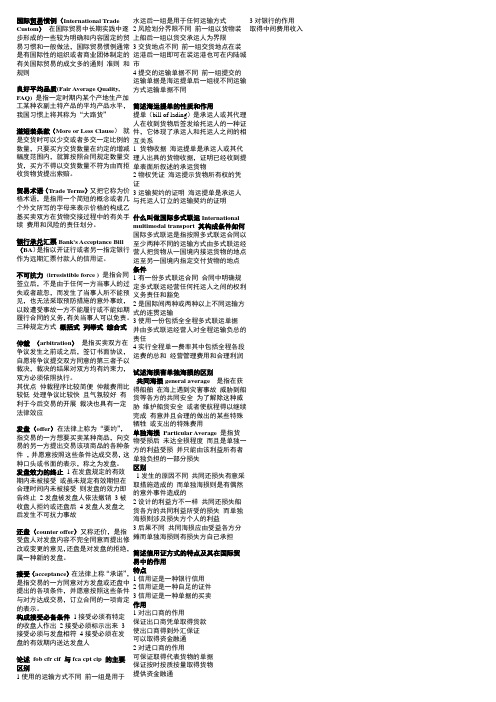
国际贸易惯例(International Trade Custom ) 在国际贸易中长期实践中逐步形成的一些较为明确和内容固定的贸易习惯和一般做法,国际贸易惯例通常是有国际性的组织或者商业团体制定的有关国际贸易的成文多的通则 准则 和规则 良好平均品质(Fair Average Quality, FAQ) 是指一定时期内某个产地生产加工某种农副土特产品的平均产品水平,我国习惯上将其称为“大路货” 溢短装条款(More or Less Clause ) 就是交货时可以少交或者多交一定比例的数量,只要买方交货数量在约定的增减幅度范围内,就算按照合同规定数量交货,买方不得以交货数量不符为由而拒收货物货提出索赔。
贸易术语(Trade Terms )又把它称为价格术语,是指用一个简短的概念或者几个外文所写的字母来表示价格的构成乙基买卖双方在货物交接过程中的有关手续 费用和风险的责任划分。
银行承兑汇票Bank's Acceptance Bill (BA )是指以开证行或者另一指定银行作为远期汇票付款人的信用证。
不可抗力 (irresistible force ) 是指合同签立后,不是由于任何一方当事人的过失或者疏忽,而发生了当事人所不能预见,也无法采取预防措施的意外事故,以致遭受事故一方不能履行或不能如期履行合同的义务,有关当事人可以免责。
三种规定方式 概括式 列举式 综合式 仲裁 (arbitration ) 是指买卖双方在争议发生之前或之后,签订书面协议,自愿将争议提交双方同意的第三者予以裁决,裁决的结果对双方均有约束力,双方必须依照执行。
其优点 仲裁程序比较简便 仲裁费用比较低 处理争议比较快 且气氛较好 有利于今后交易的开展 裁决也具有一定法律效应 发盘(offer )在法律上称为“要约”,指交易的一方想要买卖某种商品,向交易的另一方提出交易该项商品的各种条件 ,并愿意按照这些条件达成交易,这种口头或书面的表示,称之为发盘。
国际贸易专业英语整理

国际贸易专业英语整理第一篇:国际贸易专业英语整理可能出翻译(1)FOB: Free on Board(…named port of shipment)装运港船上交货(……指定装运港)“Free on Board” means that the seller fulfils his obligation to deliver when the goods have passed over the ship’s rail at thenamed port of shipment.(2)CFR: Cost and Freight(…named port of destination)成本加运费(……指定目的港)“Cost and Freight” means that the seller is responsible for chartering a liner and loading the goods on the liner at the stipulated time in the contract.(3)CIF: Cost Insurance and Freight(…named port of destination)成本、保险加运费(……指定目的港)“Cost Insurance and Freight” means that the seller has the obligations to procure marine insurance against the risks of losses of, or damage to the goods during the carriage.1.The theory ofcomparative advantageAlthough Smith’s work was instrumental in the development of economic theories about trade and production, it did not answer a question like if a country did not possess absolute advantage in any product, could it(or would it)trade ?尽管斯密的著作在贸易和生产相关的经济理论上有指导意义,但他没有回答类似于一个国家若没有绝对优势能否贸易这样的问题。
国际贸易复习要点
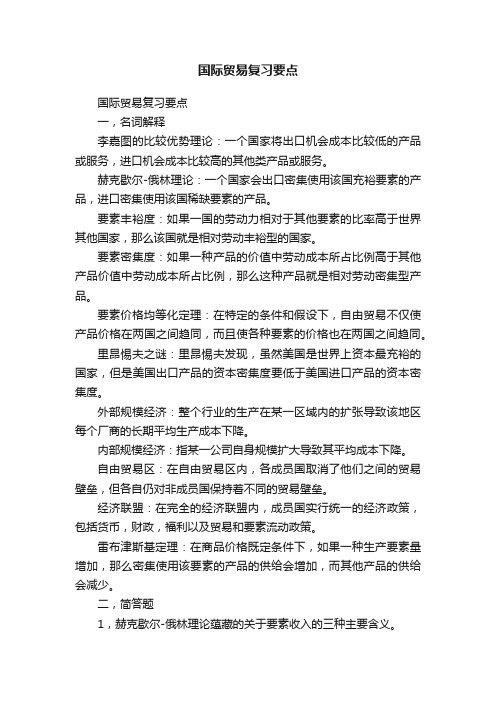
国际贸易复习要点国际贸易复习要点一,名词解释李嘉图的比较优势理论:一个国家将出口机会成本比较低的产品或服务,进口机会成本比较高的其他类产品或服务。
赫克歇尔-俄林理论:一个国家会出口密集使用该国充裕要素的产品,进口密集使用该国稀缺要素的产品。
要素丰裕度:如果一国的劳动力相对于其他要素的比率高于世界其他国家,那么该国就是相对劳动丰裕型的国家。
要素密集度:如果一种产品的价值中劳动成本所占比例高于其他产品价值中劳动成本所占比例,那么这种产品就是相对劳动密集型产品。
要素价格均等化定理:在特定的条件和假设下,自由贸易不仅使产品价格在两国之间趋同,而且使各种要素的价格也在两国之间趋同。
里昂惕夫之谜:里昂惕夫发现,虽然美国是世界上资本最充裕的国家,但是美国出口产品的资本密集度要低于美国进口产品的资本密集度。
外部规模经济:整个行业的生产在某一区域内的扩张导致该地区每个厂商的长期平均生产成本下降。
内部规模经济:指某一公司自身规模扩大导致其平均成本下降。
自由贸易区:在自由贸易区内,各成员国取消了他们之间的贸易壁垒,但各自仍对非成员国保持着不同的贸易壁垒。
经济联盟:在完全的经济联盟内,成员国实行统一的经济政策,包括货币,财政,福利以及贸易和要素流动政策。
雷布津斯基定理:在商品价格既定条件下,如果一种生产要素量增加,那么密集使用该要素的产品的供给会增加,而其他产品的供给会减少。
二,简答题1,赫克歇尔-俄林理论蕴藏的关于要素收入的三种主要含义。
答:(1),国内充裕要素的所有者从贸易中获利,而稀缺要素的所有者因贸易而受损。
(2),当某一要素价格上升时,则密集使用该要素的产品的价格也会上升;当某一要素价格下降时,则密集使用该要素的产品的价格也会随之下降。
(3),贸易的结果可以使商品价格均等化,某种程度上也可使生产要素价格均等化。
2,有经济学研究者认为:就短期而言,自由贸易会损害进口替代产业从业人员的利益,但当长期内人员和资源实现不同产业间的流动时,人人皆将受益于自由贸易。
国际贸易名词解释英文及简答论述期末考试复习资料

《国际贸易》英文名词解释International Trade(国际贸易)International trade is the international exchange of goods and services between countries. This type of trade gives rise to a world economy, in which prices, or supply and demand, affect and are affected by global events.Free Trade(自由贸易)The main idea of free trade is that supply and demand factors, operating on a global scale, will ensure that production happens efficiently. Therefore, nothing needs to protect or promote trade and growth because market forces will do so automatically.Protectionism(贸易保护主义)In contrast, protectionism holds that regulation of international trade is important to ensure that markets function properly. Advocates of this theory believe that market inefficiencies may hamper the benefits of international trade and they aim to guide the market accordingly.Production Possibilities Curve /Frontier(生产可能性曲线/边界)A Production Possibilities Frontier is a graph that shows the various combinations of output that the economy can possibly produce, given the availablefactors of production and the existing technology .Opportunity Cost(机会成本)Opportunity Cost means whatever must be given up to obtain some item. Supply Curve(供给曲线)A Supply Curve is a graph that shows the relationship between the price of a good and the quantity supplied.Demand Curve (需求曲线)A Demand Curve is a graph that describes the relationship between the price of a good and the quantity demanded.Excess Supply Curve(出口供给曲线)Because Excess Supply is a situation in which quantity supplied is greater than quantity demanded, Excess Supply Curve can be defined as a graph that depicts the relationship between the price and the available quantity for export of a product. Excess Supply Curve can be derived from subtracting a supply curve with a corresponding demand curve.Excess Demand Curve(进口需求曲线)Because Excess Demand is a situation in which quantity demanded is greater than quantity supplied, Excess Demand Curve can be defined as a graph that depicts therelationship between the price and the desirable quantity for import of a product. Excess Demand Curve can be derived from subtracting a demand curve with a corresponding supply curve.Consumer Surplus(消费者剩余)Consumer Surplus means a buyer’s willingness to pay minus the amount the buyer actually pays. Consumer surplus measures the benefit to buyers of participating in a market.Producer Surplus (生产者剩余)Producer Surplus is the amount a seller is paid for a good minus the seller’s cost. Producer surplus measures the benefit to sellers of participating in a market.Economies of Scale(规模经济)Economies of Scale means the property whereby the long-run average cost falls as the quantity of output increases.Diseconomies of Scale(规模不经济)Diseconomies of Scale means the property whereby the long-run average cost rises as the quantity of output increases.Constant Returns to Scale(规模报酬不变)Constant Returns to Scale means the property whereby the long-run average cost stays the same as the quantity of output changes.Indifference Curve(无差异曲线)Indifference Curve is a curve that shows consumption bundles that give the consumer the same level of satisfaction.The Gravity Model(引力模型)In its basic form, the gravity model assumes that only size and distance(经济规模和距离) are important for trade in the following way:Tij = A x Yi x Yj /Dij 两国之间的贸易规模与经济规模成正比,与两国之间的距离成反比。
国际贸易名词解释

国际贸易名词解释1.国际贸易(nale Trade)是指世界各国(或地区)之间商品和劳务的交换活动,是各国在国际分工的基础上相互联系的主要形式,反映了世界各国在经济上的相互联系与依赖的关系。
2.净出口(净进口)是指一国(或地区)在一定时期内(一般以一年度计算),在同种商品上既有进口也有出口,当出口数大于(或小于)进口数时称之。
3.复出口(复进口)是指国外(本国)商品进口(出口)后未经加工制造又出口(进口)。
4.贸易条件:一般指出口商品价格与进口商品价格之间的比率,又称“进出换比价”或“交换比价”。
由于所涉及的是一个国家的种类繁多的所有进出口商品的价格,固常用贸易条件指数。
5.对外贸易量:指用进出口商品的计量单位(如数量、重量等)表示的反映贸易规模的指标。
它可以剔除价格波动的影响,是世界贸易组织和大多数国家采用来衡量贸易规模的指标。
6.对外贸易依存度:是一个国家在一定时期内进出口贸易值与该国同期国民(国内)生产总值(GNP、GDP)的对比关系。
是衡量一个国家国民经济发展对对外贸易依赖程度的一个指标,可细分为进口与出口对外依存度7.过境贸易(Transit Trade)指贸易货物在运输途中经过一国国境,这些货物既不在该国销售,该国也不参与到贸易当中,只是供给交通的便利,并收取少量费用。
8.转口贸易(EntreportTrade)转口贸易是指一国(或地区)进口某种商品不是以消费为目的,而是将它作为商品再向别国出口的贸易活动。
9.国际分工(XXX):是指世界各国(地区)之间的劳动分工,是各国生产者通过世界市场形成的劳动联系,也是国际贸易和各国(地区)经济联系的基础。
它还是各国民经济发展到一定阶段,国民经济内部分工超越国家界限发展的结果,同时也是生产社会化向国际化发展的趋势。
10.资源禀赋:是指一国自然拥有地各种生产要素(通常指土地、劳动、资本)的数量。
11.要素密集度(Factor Intensity)指产品出产中某种要素投入比例的大小,如果某要素投入比例大,称为该要素密集度程度高。
《国际贸易》期末考试名词解释汇总

17.产品生命周期理论(Theory of product life cycle):其基本涵义可以通俗地理解为“从摇篮到坟墓”(Cradle-to-Grave)的整个过程。是产品的市场寿命,即一种新产品从开始进入市场到被市场淘汰的整个过程。
4.重商主义(‘Mercantilism):核心观点是:认为财富就是货币,货币即财富;财富的直接源泉来自于流通领域;一个国家必不可少的财富是金银等贵金属,金银是国家财富的唯一形态,是衡量国家富裕程度的惟一尺度。
5.要素禀赋(Factor endowment):指一国所拥有的各种生产要素的总量,既包括先天存在的自然资源(如土地、矿产),也包括后天获得的资源(如资本和技术),是一个绝对量的概念。
9.外部规模经济(External economics of scale):指由于整个产业的产出水平增加而导致每个厂商的平均成本下降。即外部规模经济的实现只依赖于产业规模,而不是单个厂商的规模。
10.内部规模经济(Internal economics of scale):指由于单个厂商自身规模扩大和产出水平增加而导致的平均成本下降。
48.普惠制税(Generalized System of Preferences,GSP):是联合国体制下的一项贸易优惠制度,安排发达国家给予来自发展中国家的商品(主要是制成品和半制成品)普遍的、非歧视的、非互惠的进口税率。其目的是为了发展中国家增加出口收益和促进工业化。
国际贸易名词解释英文简答论述期末考试复习资料
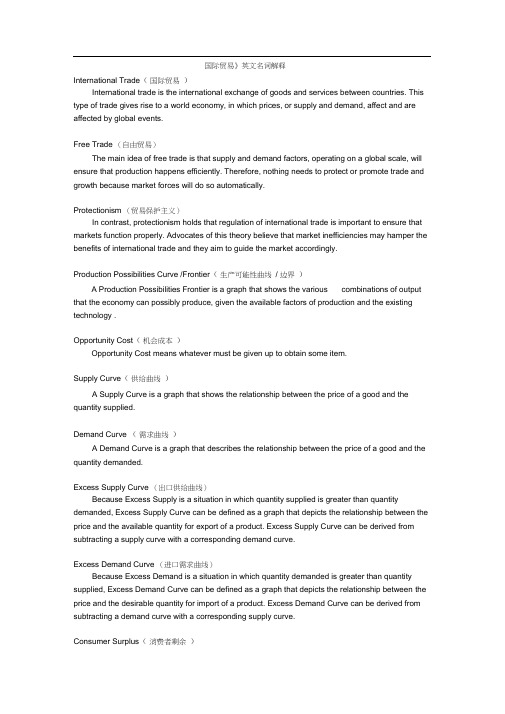
国际贸易》英文名词解释International Trade(国际贸易)International trade is the international exchange of goods and services between countries. This type of trade gives rise to a world economy, in which prices, or supply and demand, affect and are affected by global events.Free Trade (自由贸易)The main idea of free trade is that supply and demand factors, operating on a global scale, will ensure that production happens efficiently. Therefore, nothing needs to protect or promote trade and growth because market forces will do so automatically.Protectionism (贸易保护主义)In contrast, protectionism holds that regulation of international trade is important to ensure that markets function properly. Advocates of this theory believe that market inefficiencies may hamper the benefits of international trade and they aim to guide the market accordingly.Production Possibilities Curve /Frontier(生产可能性曲线/ 边界)A Production Possibilities Frontier is a graph that shows the various combinations of output that the economy can possibly produce, given the available factors of production and the existing technology .Opportunity Cost(机会成本)Opportunity Cost means whatever must be given up to obtain some item.Supply Curve(供给曲线)A Supply Curve is a graph that shows the relationship between the price of a good and the quantity supplied.Demand Curve (需求曲线)A Demand Curve is a graph that describes the relationship between the price of a good and the quantity demanded.Excess Supply Curve (出口供给曲线)Because Excess Supply is a situation in which quantity supplied is greater than quantity demanded, Excess Supply Curve can be defined as a graph that depicts the relationship between the price and the available quantity for export of a product. Excess Supply Curve can be derived from subtracting a supply curve with a corresponding demand curve.Excess Demand Curve (进口需求曲线)Because Excess Demand is a situation in which quantity demanded is greater than quantity supplied, Excess Demand Curve can be defined as a graph that depicts the relationship between the price and the desirable quantity for import of a product. Excess Demand Curve can be derived from subtracting a demand curve with a corresponding supply curve.Consumer Surplus(消费者剩余)Consumer Surplus means a buyer' s willingness to pay minus the amount the buyer actually pays. Consumer surplus measures the benefit to buyers of participating in a market.Producer Surplus (生产者剩余)Producer Surplus is the amount a seller is paid for a good minus the seller ' s cost. Producer surplus measures the benefit to sellers of participating in a market.Economies of Scale(规模经济)Economies of Scale means the property whereby the long-run average cost falls as the quantity of output increases.Diseconomies of Scale(规模不经济)Diseconomies of Scale means the property whereby the long-run average cost rises as the quantity of output increases.Constant Returns to Scale(规模报酬不变)Constant Returns to Scale means the property whereby the long-run average cost stays the same as the quantity of output changes.Indifference Curve(无差异曲线)Indifference Curve is a curve that shows consumption bundles that give the consumer the same level of satisfaction.The Gravity Model(引力模型)In its basic form, the gravity model assumes that only size and distance(经济规模和距离) are important for trade in the following way :Tij = A x Yi x Yj /Dij两国之间的贸易规模与经济规模成正比,与两国之间的距离成反比。
国际贸易名词解释

1.国际贸易(International Trade) :指世界各国之间货物、服务及贸易相关的要素交换的活动,2.是各国之间劳动分工的表现形式。
对外贸易(Foreign Trade):指一个国家或地区与其他国家或地区进行的商品和劳务的交换活动。
3.海外贸易(Oversea Trade):一些海岛国家或地区将其对外贸易称为海外贸易。
4.对外贸易额(Value of Foreign Trade):以金额表示的一国对外贸易规模的指标。
对外贸易总额= 进口总额+出口总额一般:Σ各国出口贸易额反映国际贸易规模5.对外贸易量(Quantum of Foreign Trade):指以不变价格计算的反映贸易规模的指标。
对外贸易量= 对外贸易额/ 价格指数6.对外贸易地理方向(地区分布):在一定时期内,一个国家的出口商品流向和进口商品来源,常用一国对各国或地区的贸易额占该国对外贸易总额的比例反映。
7. 国际贸易地理方向(地区分布):世界各洲、各国或各个集团在国际贸易中所占的地位。
常用各国或地区的贸易额占世界贸易总额的比例反映。
8.对外贸易依存度(Y):也称对外贸易系数或开放指数Y=(Σ进口额+Σ出口额)/GNP或GDPGNP(国民生产总值)GDP(国内生产总值)9.对外贸易货物结构:一定时期内,一国进出口贸易中各类货物的构成;10.对外贸易货物结构:一般以制成品、半制成品、初级产品在该国对外贸易中所占的比例反映11.贸易条件= 出口商品价格/进口商品价格12.贸易条件指数= 出口商品价格指数/进口商品价格指数13.过境交付: 即服务者提供者和消费者都不跨越国境14.境外消费:即服务消费者到服务提供者国内接受服务15.商业存在:服务企业到国外开办服务场所,提供服务16.自然人流动: 一国自然人到服务消费者所在国或第三国提供服务17.市场经济需要对外贸易:①商品生产的发展需要国际贸易:②社会化大生产需要国际贸易:社会化大生产的根本特点:分工的深化和交换的扩大18.关境:关境是一个国家海关法规全部生效的领域。
国际贸易备考复习题 附带参考答案

国际贸易练习题第一章国际贸易的基本概念与历史发展名词解释1.国际贸易:国际贸易(International Trade)也称通商,是指跨越国境的和交易,一般由和所组成,因此也可称之为进出口贸易。
国际贸易也叫世界贸易。
进出口贸易可以调节国内的利用率,改善国际间的供求关系,调整,增加等2.总贸易体系与专门贸易体系:总贸易体系(General Trade System)又称体系,是以通过国境作为统计的标准。
凡是进入本国国境的货物一律记为进口,称为“总进口”(General Import);凡是离开本国国境的货物一律计为出口,称为“总出口”(General Export),两者之和为总。
3.国际贸易额与国际贸易量:国际贸易额,又称国际贸易值,是用货币表示的反映一定时期内世界贸易规模的对外贸易总额,它能反映出某一时期内的贸易总金额,也称国际贸易额;国际贸易量:是为了剔除了价格变动影响,能准确反映国际贸易的实际数量,而确立的一个指标。
在计算时,是以固定年份为基期而确定的价格指数去除报告期的国际贸易额,得到的就是相当于按不变价格计算(剔除价格变动的影响)的国际贸易额,该数值就叫报告期的国际贸易量。
4.对外贸易依存度:对外贸易依存度又称为对外贸易系数(传统的对外贸易系数),是指一国的进出口总额占该国国民生产总值或国内生产总值的比重。
其中,进口总额占GNP或 GDP的比重称为进口依存度,出口总额占GNP或GDP的比重称为出口依存度。
对外贸易依存度反映一国对国际市场的依赖程度,是衡量一国对外开放程度的重要指标。
5.直接贸易与间接贸易:间接贸易(Indirect Trade),“直接贸易”的对称,是指商品生产国与商品消费国通过第三国进行卖买商品的行为。
其中,生产国是间接出口;消费国是间接进口;第三国是转口;间接贸易(Indirect Trade),“直接贸易”的对称,是指商品生产国与商品消费国通过第三国进行卖买商品的行为。
国际贸易名词解释英文及简答论述 期末考试复习

《国际贸易》英文名词解释International Trade(国际贸易)International trade is the international exchange of goods and services between countries. This type of trade gives rise to a world economy, in which prices, or supply and demand, affect and are affected by global events.Free Trade(自由贸易)The main idea of free trade is that supply and demand factors, operating on a global scale, will ensure that production happens efficiently. Therefore, nothing needs to protect or promote trade and growth because market forces will do so automatically.Protectionism(贸易保护主义)In contrast, protectionism holds that regulation of international trade is important to ensure that markets function properly. Advocates of this theory believe that market inefficiencies may hamper the benefits of international trade and they aim to guide the market accordingly. Production Possibilities Curve /Frontier(生产可能性曲线/边界)A Production Possibilities Frontier is a graph that shows the various combinations of output that the economy can possibly produce, given the available factors of production and the existing technology . Opportunity Cost(机会成本)Opportunity Cost means whatever must be given up to obtain some item.Supply Curve(供给曲线)A Supply Curve is a graph that shows the relationship between the price of a good and the quantity supplied.Demand Curve (需求曲线)A Demand Curve is a graph that describes the relationship between the price of a good and the quantity demanded.Excess Supply Curve(出口供给曲线)Because Excess Supply is a situation in which quantity supplied is greater than quantity demanded, Excess Supply Curve can be defined as a graph that depicts the relationship between the price and the available quantity for export of a product. Excess Supply Curve can be derived from subtracting a supply curve with a corresponding demand curve.Excess Demand Curve(进口需求曲线)Because Excess Demand is a situation in which quantity demanded is greater than quantity supplied, Excess Demand Curve can be defined as a graph that depicts the relationship between the price and the desirable quantity for import of a product. Excess Demand Curve can be derived from subtracting a demand curve with a corresponding supply curve.Consumer Surplus(消费者剩余)Consumer Surplus means a buyer’s willingness to pay minus the amount the buyer actually pays. Consumer surplus measures the benefit to buyers of participating in a market.Producer Surplus (生产者剩余)Producer Surplus is the amount a seller is paid for a good minus the seller’s cost. Producer surplus measures the benefit to sellers of participating in a market.Economies of Scale(规模经济)Economies of Scale means the property whereby the long-run average cost falls as the quantity of output increases.Diseconomies of Scale(规模不经济)Diseconomies of Scale means the property whereby the long-run average cost rises as the quantity of output increases.Constant Returns to Scale(规模报酬不变)Constant Returns to Scale means the property whereby the long-run average cost stays the same as the quantity of output changes. Indifference Curve(无差异曲线)Indifference Curve is a curve that shows consumption bundles that give the consumer the same level of satisfaction.The Gravity Model(引力模型)In its basic form, the gravity model assumes that only size and distance(经济规模和距离) are important for trade in the following way:Tij = A x Yi x Yj /Dij两国之间的贸易规模与经济规模成正比,与两国之间的距离成反比。
国际贸易 名词解释中英文 自己整理
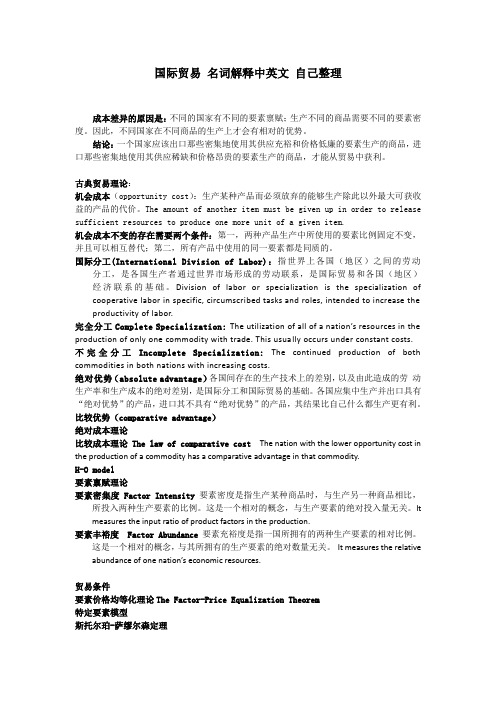
国际贸易名词解释中英文自己整理成本差异的原因是:不同的国家有不同的要素禀赋;生产不同的商品需要不同的要素密度。
因此,不同国家在不同商品的生产上才会有相对的优势。
结论:一个国家应该出口那些密集地使用其供应充裕和价格低廉的要素生产的商品,进口那些密集地使用其供应稀缺和价格昂贵的要素生产的商品,才能从贸易中获利。
古典贸易理论:机会成本(opportunity cost):生产某种产品而必须放弃的能够生产除此以外最大可获收益的产品的代价。
The amount of another item must be given up in order to release sufficient resources to produce one more unit of a given item.机会成本不变的存在需要两个条件:第一,两种产品生产中所使用的要素比例固定不变,并且可以相互替代;第二,所有产品中使用的同一要素都是同质的。
国际分工(International Division of Labor):指世界上各国(地区)之间的劳动分工,是各国生产者通过世界市场形成的劳动联系,是国际贸易和各国(地区)经济联系的基础。
Division of labor or specialization is the specialization of cooperative labor in specific, circumscribed tasks and roles, intended to increase the productivity of labor.完全分工Complete Specialization: The utilization of all of a nation’s resources in the production of only one commodity with trade. This usually occurs under constant costs. 不完全分工Incomplete Specialization: The continued production of both commodities in both nations with increasing costs.绝对优势(absolute advantage)各国间存在的生产技术上的差别,以及由此造成的劳动生产率和生产成本的绝对差别,是国际分工和国际贸易的基础。
国际贸易英语知识点总结

国际贸易英语知识点总结一、国际贸易术语(Incoterms)1. FOB (Free on Board)- 含义:卖方在指定的装运港将货物装上买方指定的船只后,卖方即完成交货义务。
风险在货物越过船舷时转移给买方。
- 示例:We offer the goods FOB Shanghai.(我们提供上海港船上交货价的货物。
)- 相关费用:卖方负责将货物运至装运港船上之前的一切费用,包括国内运输、装卸等费用;买方负责从装运港到目的港的运费、保险费等。
2. CIF (Cost, Insurance and Freight)- 含义:卖方负责支付货物成本、保险费和运费,将货物运至指定目的港。
- 示例:The price is quoted CIF New York.(价格报的是纽约港到岸价。
)- 相关费用:卖方承担货物到达目的港之前的成本、保险费和运费;买方负责卸货后的费用,如进口关税等。
风险在货物越过装运港船舷时转移给买方。
3. CFR (Cost and Freight)- 含义:卖方负责货物成本和运费,将货物运至指定目的港。
与CIF相比,不包含保险费。
- 示例:We can supply the goods CFR London.(我们可以供应伦敦港成本加运费价的货物。
)- 相关费用:卖方承担货物运至目的港的成本和运费,买方负责保险费及卸货后的费用。
风险在货物越过装运港船舷时转移给买方。
二、商务信函写作。
1. 信头(Letterhead)- 包含公司名称、地址、联系方式(电话、传真、电子邮箱等)。
- 例如:ABC Company.123 Main Street, New York, NY 10001.Tel: +1 - 212 - 1234567.Fax: +1 - 212 - 1234568.Email:*******************.2. 称呼(Salutation)- 如果知道对方姓名,用“Dear Mr./Ms. + 姓氏”,如“Dear Mr. Smith”;如果不知道具体姓名,可用“Dear Sir/Madam”或者“To Whom It May Concern”。
国际贸易法复习名词解释
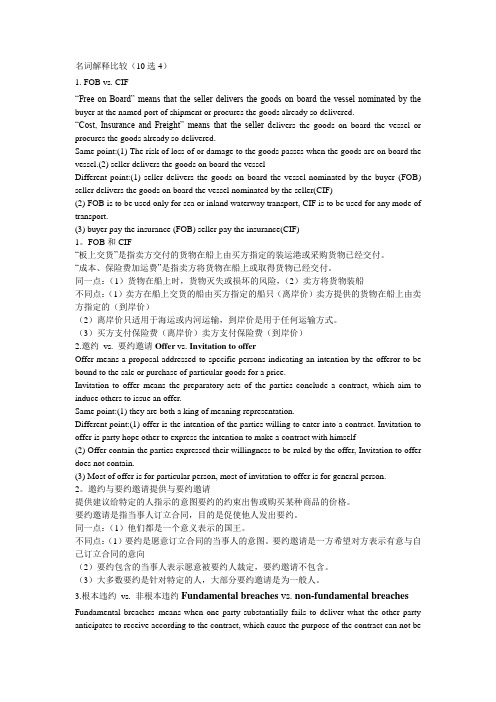
名词解释比较(10选4)1. FOB vs. CIF“Free on Board” means that the seller delivers the goods on board the vessel nominated by the buyer at the named port of shipment or procures the goods already so delivered.“Cost, Insurance and Freight” means that the seller d elivers the goods on board the vessel or procures the goods already so delivered.Same point:(1) The risk of loss of or damage to the goods passes when the goods are on board the vessel.(2) seller delivers the goods on board the vesselDifferent point:(1) seller delivers the goods on board the vessel nominated by the buyer (FOB) seller delivers the goods on board the vessel nominated by the seller(CIF)(2) FOB is to be used only for sea or inland waterway transport, CIF is to be used for any mode of transport.(3) buyer pay the insurance (FOB) seller pay the insurance(CIF)1。
国际贸易实务期末考试试卷三(附满分答案)
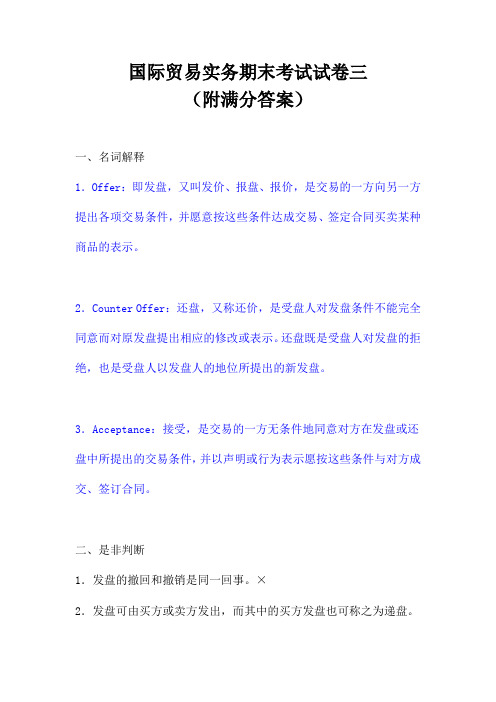
国际贸易实务期末考试试卷三(附满分答案)一、名词解释1.Offer:即发盘,又叫发价、报盘、报价,是交易的一方向另一方提出各项交易条件,并愿意按这些条件达成交易、签定合同买卖某种商品的表示。
2.Counter Offer:还盘,又称还价,是受盘人对发盘条件不能完全同意而对原发盘提出相应的修改或表示。
还盘既是受盘人对发盘的拒绝,也是受盘人以发盘人的地位所提出的新发盘。
3.Acceptance:接受,是交易的一方无条件地同意对方在发盘或还盘中所提出的交易条件,并以声明或行为表示愿按这些条件与对方成交、签订合同。
二、是非判断1.发盘的撤回和撤销是同一回事。
×2.发盘可由买方或卖方发出,而其中的买方发盘也可称之为递盘。
√3.接受一旦送到发盘人,不得撤销。
×4.我某公司与国外洽谈一笔玉雕交易,经过双方对交易条件往返磋商之后,已就价格、数量、交货期等达成协议,我方公司于是在8月6日致电对方:“确认售与你方玉雕一件,请先电汇一万美元”。
对方于8月9日复电:“确认你方电报,我购玉雕一件,条件按你方电报规定,已汇交你方银行一万美元,该款在交货前由银行代你方保管。
”这笔交易于是达成。
×5.凡对外签订的贸易合同都属于重要的涉外经济合同,因此,在发生争议时,都应按照我国有关法律处理。
×6.逾期送达发盘人的接受,只要发盘人默认,合同即成立。
×7.在国际贸易中,一项合同的有效成立都必须经过询盘、发盘、还盘、接受和签约等五个环节。
×8.发盘必须明确规定有效期,未规定有效期的发盘无效。
×9.在交易磋商过程中,发盘是由卖方作出的行为,接受是由买方作出的行为。
×10.《公约》规定,如果在发盘中已经规定了有效期,则在该发盘生效后,发盘人仍可以撤销该发盘。
×11.根据《公约》规定,受盘人可以在发盘有效期内用开立信用证这一行为表示接受。
√12.一项发盘表明是不可撤销的发盘,则意味着发盘人无权撤回该发盘。
国际贸易学期末复习
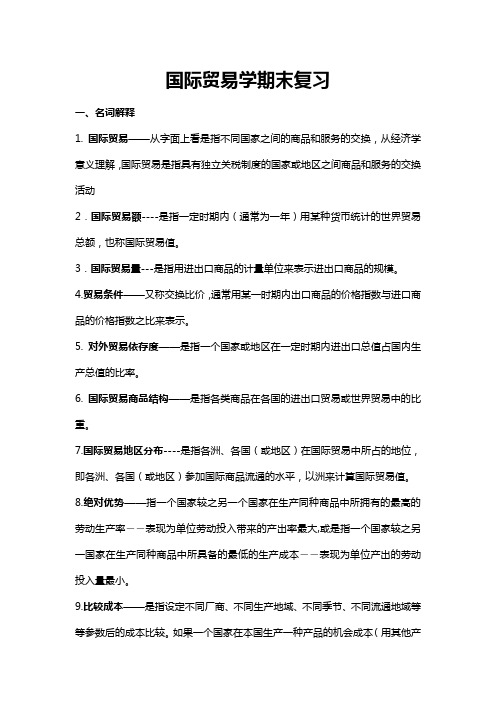
国际贸易学期末复习一、名词解释1.国际贸易——从字面上看是指不同国家之间的商品和服务的交换,从经济学意义理解,国际贸易是指具有独立关税制度的国家或地区之间商品和服务的交换活动2.国际贸易额----是指一定时期内(通常为一年)用某种货币统计的世界贸易总额,也称国际贸易值。
3.国际贸易量---是指用进出口商品的计量单位来表示进出口商品的规模。
4.贸易条件——又称交换比价,通常用某一时期内出口商品的价格指数与进口商品的价格指数之比来表示。
5. 对外贸易依存度——是指一个国家或地区在一定时期内进出口总值占国内生产总值的比率。
6. 国际贸易商品结构——是指各类商品在各国的进出口贸易或世界贸易中的比重。
7.国际贸易地区分布----是指各洲、各国(或地区)在国际贸易中所占的地位,即各洲、各国(或地区)参加国际商品流通的水平,以洲来计算国际贸易值。
8.绝对优势——指一个国家较之另一个国家在生产同种商品中所拥有的最高的劳动生产率――表现为单位劳动投入带来的产出率最大,或是指一个国家较之另一国家在生产同种商品中所具备的最低的生产成本――表现为单位产出的劳动投入量最小。
9.比较成本——是指设定不同厂商、不同生产地域、不同季节、不同流通地域等等参数后的成本比较。
如果一个国家在本国生产一种产品的机会成本(用其他产品来衡量)低于在其他国家生产该产品的机会成本的话,则这个国家在生产该种产品上就拥有比较优势。
10.要素禀赋----是指一国所拥有的两种生产要素的相对比例,即要素存量比例,是个相对量,而不是绝对量11.幼稚产业保护论---一一种对某些产业采取过渡性的保护、扶植措施的理论,是国际贸易中贸易保护主义的基本理论。
其基本内容是:某个国家的一个新兴产业,当其还处于最适度规模的初创时期时,可能经不起外国的竞争。
如果通过对该产业采取适当的保护政策,提高其竞争能力,将来可以具有比较优势,能够出口并对国民经济发展做出贡献的,就应采取过渡性的保护、扶植政策。
国际贸易知识要点复习资料全
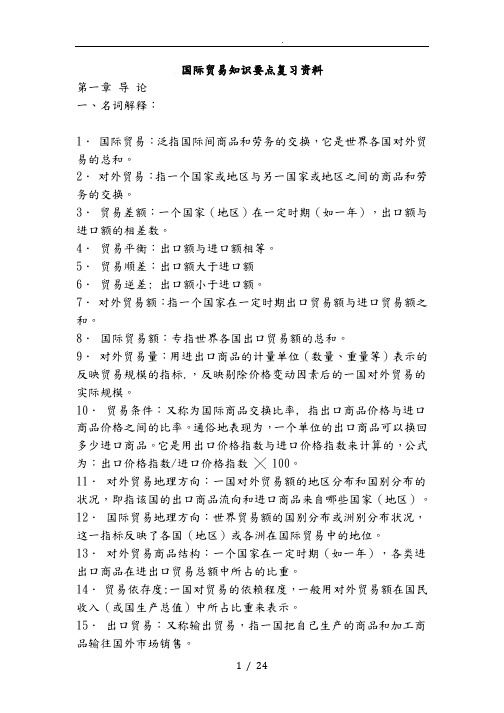
国际贸易知识要点复习资料第一章导论一、名词解释:1.国际贸易:泛指国际间商品和劳务的交换,它是世界各国对外贸易的总和。
2.对外贸易:指一个国家或地区与另一国家或地区之间的商品和劳务的交换。
3.贸易差额:一个国家(地区)在一定时期(如一年),出口额与进口额的相差数。
4.贸易平衡:出口额与进口额相等。
5.贸易顺差:出口额大于进口额6.贸易逆差: 出口额小于进口额。
7.对外贸易额:指一个国家在一定时期出口贸易额与进口贸易额之和。
8.国际贸易额:专指世界各国出口贸易额的总和。
9.对外贸易量:用进出口商品的计量单位(数量、重量等)表示的反映贸易规模的指标.,反映剔除价格变动因素后的一国对外贸易的实际规模。
10.贸易条件:又称为国际商品交换比率, 指出口商品价格与进口商品价格之间的比率。
通俗地表现为,一个单位的出口商品可以换回多少进口商品。
它是用出口价格指数与进口价格指数来计算的,公式为:出口价格指数/进口价格指数╳ 100。
11.对外贸易地理方向:一国对外贸易额的地区分布和国别分布的状况,即指该国的出口商品流向和进口商品来自哪些国家(地区)。
12.国际贸易地理方向:世界贸易额的国别分布或洲别分布状况,这一指标反映了各国(地区)或各洲在国际贸易中的地位。
13.对外贸易商品结构:一个国家在一定时期(如一年),各类进出口商品在进出口贸易总额中所占的比重。
14.贸易依存度:一国对贸易的依赖程度,一般用对外贸易额在国民收入(或国生产总值)中所占比重来表示。
15.出口贸易:又称输出贸易,指一国把自己生产的商品和加工商品输往国外市场销售。
16.进口贸易:又称输入贸易,指一国从国外市场购进用以生产或消费的商品。
17.过境贸易:某种商品从甲国经乙国向丙国输送销售,对乙国来说,就是过境贸易。
18.总贸易:以国境作为划分进出口的标准。
19.专门贸易:把关境作为划分进出口的标准。
20.有形贸易:指那些有形的、可以看得见的物质性商品的进出口贸易活动。
国际贸易备考复习题(附带参考答案)

国际贸易练习题第一章国际贸易的基本概念与历史发展名词解释1.国际贸易:国际贸易(International Trade)也称通商,是指跨越国境的货品和服务交易,一般由进口贸易和出口贸易所组成,因此也可称之为进出口贸易。
国际贸易也叫世界贸易。
进出口贸易可以调节国内生产要素的利用率,改善国际间的供求关系,调整经济结构,增加财政收入等2.总贸易体系与专门贸易体系:总贸易体系(General Trade System)又称一般贸易体系,是以货物通过国境作为统计对外贸易的标准。
凡是进入本国国境的货物一律记为进口,称为“总进口”(General Import);凡是离开本国国境的货物一律计为出口,称为“总出口”(General Export),两者之和为总贸易额。
3.国际贸易额与国际贸易量:国际贸易额,又称国际贸易值,是用货币表示的反映一定时期内世界贸易规模的对外贸易总额,它能反映出某一时期内的贸易总金额,也称国际贸易额;国际贸易量:是为了剔除了价格变动影响,能准确反映国际贸易的实际数量,而确立的一个指标。
在计算时,是以固定年份为基期而确定的价格指数去除报告期的国际贸易额,得到的就是相当于按不变价格计算(剔除价格变动的影响)的国际贸易额,该数值就叫报告期的国际贸易量。
4.对外贸易依存度:对外贸易依存度又称为对外贸易系数(传统的对外贸易系数),是指一国的进出口总额占该国国民生产总值或国内生产总值的比重。
其中,进口总额占GNP或GDP的比重称为进口依存度,出口总额占GNP或GDP的比重称为出口依存度。
对外贸易依存度反映一国对国际市场的依赖程度,是衡量一国对外开放程度的重要指标。
5.直接贸易与间接贸易:间接贸易(Indirect Trade),“直接贸易”的对称,是指商品生产国与商品消费国通过第三国进行卖买商品的行为。
其中,生产国是间接出口;消费国是间接进口;第三国是转口;间接贸易(Indirect Trade),“直接贸易”的对称,是指商品生产国与商品消费国通过第三国进行卖买商品的行为。
国际经济与贸易期末考试复习重点(大全)

国贸所有期末资料汇总选择10分计算题10分 第三章第3题没有,但很简单4.在古典贸易模型中,假设A 国有120名劳动力,B 国有50名劳动力,如果生产棉花的话,A 国的人均产量是2吨,B 国也是2吨;要是生产大米的话,A 国的人均产量是10吨,B 国则是16吨。
画出两国的生产可能性曲线并分析两国中哪一国拥有生产大米的绝对优势?哪一国拥有生产大米的比较优势?思路:B 国由于每人能生产16吨大米,而A 国每人仅生产10吨大米,所以B 国具有生产大米的绝对优势。
从两国生产可能性曲线看出A 国生产大米的机会成本为0.2,而B 国为0.125,所以B 国生产大米的机会成本或相对成本低于A 国,B 国生产大米具有比较优势。
1. 5.下表列出了加拿大和中国生产1单位计算机和1单位小麦所需的劳动时间。
假定生产计算机和小麦都只用劳动,加拿大的总劳动为600小时,中国总劳动为800小时。
(1) 计算不发生贸易时各国生产计算机的机会成本。
(2) 哪个国家具有生产计算机的比较优势?哪个国家具有生产小麦的比较优势?(3) 如果给定世界价格是1单位计算机交换22单位的小麦,加拿大参与贸易可以从每单位的进口中节省多少劳动时间?中国可以从每单位进口中节省多少劳动时间?如果给定世界价格是1单位计算机交换24单位的小麦,加拿大和中国分别可以从进口每单位的货物中节省多少劳动时间?(4) 在自由贸易的情况下,各国应生产什么产品,数量是多少?整个世界的福利水平是提高还是降低了?试用图分析。
(以效用水平来衡量福利水平) 思路:(1)中国生产计算机的机会成本为100/4=25,加拿大为60/3=20(2) 因为加拿大生产计算机的机会成本比中国低,所以加拿大具有生产者计算机的比较优势,中国就具有生产小麦的比较优势。
棉花(3)如果各国按照比较优势生产和出口,加拿大进口小麦出口计算机,中国进口计算机出口小麦。
加拿大进口一单位小麦需要出口1/22单位计算机,折合成劳动时间来算,生产一单位小麦本国要用3小时,但生产1/22单位计算机本国要用60/22小时劳动,所以加拿大进口一单位小麦相当于用60/22小时的劳动换回本国3小时生产的产品,节省了3-60/22=3/11小时的劳动时间。
- 1、下载文档前请自行甄别文档内容的完整性,平台不提供额外的编辑、内容补充、找答案等附加服务。
- 2、"仅部分预览"的文档,不可在线预览部分如存在完整性等问题,可反馈申请退款(可完整预览的文档不适用该条件!)。
- 3、如文档侵犯您的权益,请联系客服反馈,我们会尽快为您处理(人工客服工作时间:9:00-18:30)。
《国际贸易》英文名词解释International Trade(国际贸易)International trade is the international exchange of goods and services between countries. This type of trade gives rise to a world economy, in which prices, or supply and demand, affect and are affected by global events.Free Trade(自由贸易)The main idea of free trade is that supply and demand factors, operating on a global scale, will ensure that production happens efficiently. Therefore, nothing needs to protect or promote trade and growth because market forces will do so automatically.Protectionism(贸易保护主义)In contrast, protectionism holds that regulation of international trade is important to ensure that markets function properly. Advocates of this theory believe that market inefficiencies may hamper the benefits of international trade and they aim to guide the market accordingly. Production Possibilities Curve /Frontier(生产可能性曲线/边界)A Production Possibilities Frontier is a graph that shows the various combinations of output that the economy can possibly produce, given the available factors of production and the existing technology . Opportunity Cost(机会成本)Opportunity Cost means whatever must be given up to obtain some item. Supply Curve(供给曲线)A Supply Curve is a graph that shows the relationship between the price of a good and the quantity supplied.Demand Curve (需求曲线)A Demand Curve is a graph that describes the relationship between the price of a good and the quantity demanded.Excess Supply Curve(出口供给曲线)Because Excess Supply is a situation in which quantity supplied is greater than quantity demanded, Excess Supply Curve can be defined as a graph that depicts the relationship between the price and the available quantity for export of a product. Excess Supply Curve can be derived from subtracting a supply curve with a corresponding demand curve. Excess Demand Curve(进口需求曲线)Because Excess Demand is a situation in which quantity demanded is greater than quantity supplied, Excess Demand Curve can be defined as a graph that depicts the relationship between the price and the desirable quantity for import of a product. Excess Demand Curve can be derived from subtracting a demand curve with a corresponding supply curve. Consumer Surplus(消费者剩余)Consumer Surplus means a buyer’s willingness to pay minus the amount the buyer actually pays. Consumer surplus measures the benefit to buyersof participating in a market.Producer Surplus (生产者剩余)Producer Surplus is the amount a seller is paid for a good minus the seller’s cost. Producer surplus measures the benefit to sellers of participating in a market.Economies of Scale(规模经济)Economies of Scale means the property whereby the long-run average cost falls as the quantity of output increases.Diseconomies of Scale(规模不经济)Diseconomies of Scale means the property whereby the long-run average cost rises as the quantity of output increases.Constant Returns to Scale(规模报酬不变)Constant Returns to Scale means the property whereby the long-run average cost stays the same as the quantity of output changes. Indifference Curve(无差异曲线)Indifference Curve is a curve that shows consumption bundles that give the consumer the same level of satisfaction.The Gravity Model(引力模型)In its basic form, the gravity model assumes that only size and distance(经济规模和距离) are important for trade in the following way:Tij = A x Yi x Yj /Dij两国之间的贸易规模与经济规模成正比,与两国之间的距离成反比。
Service Outsourcing(服务外包)Service outsourcing occurs when a firm that provides services moves its operations to a foreign location.(服务外包是指一个企业将原本由自己提供的服务转移给国外供应商。
)Mercantilism(重商主义)Belief that nation could become rich and powerful only by exporting more than it imported.Mercantilists measured wealth of a nation by stock of precious metals it possessedAbsolute Advantage(绝对优势)A nation has absolute advantage over another nation if it can produce a commodity more efficiently. When one nation has absolute advantage in production of a commodity, but an absolute disadvantage with respect to the other nation in a second commodity, both nations can gain by specializing in their absolute advantage good and exchanging part of the output for the commodity of its absolute disadvantage.Comparative Advantage(比较优势)Even if one nation is less efficient than (has absolute disadvantage with respect to) the other nation in production of both commodities, there is still a basis for mutually beneficial trade.Production Possibilities(生产可能性)The production possibility frontier (PPF) of an economy shows themaximum amount of a goods that can be produced for a fixed amount of resources.Factor Endowment (要素禀赋)the overall amount of productive factors , such as capital, labor, and land, available to one nation.Factor Abundance(要素丰裕度)There are two ways to define factor abundance. One way is in terms of physical units(i.e., in terms of the overall amount of capital and labor available to each nation). Another way is in terms of relative factor price(i.e., in terms of the rental price of capital and the price of labor time in each nation).Factor Intensity (要素密集度)In a world of two commodities (X and Y) and two factors (labor and capital), at any given wage-interest, we say that commodity Y is capital intensive if the capital-labor ratio (K/L) used in the production of Y is greater than K/L used in the production of X.Heckscher-OhlinTheorem(H-O定理)An economy is predicted to export goods that are intensive in its abundant factors of production and import goods that are intensive in its scarce factors of production.(一个国家将出口密集使用其相对丰富要素的商品,进口密集使用其相对稀缺要素的商品。
